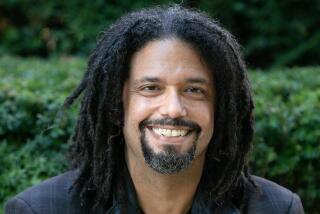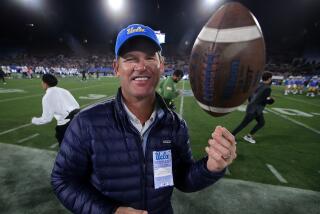Pro Football / Bob Oates : New Stadium for Bears and Cubs May Be Built on Arlington Park Site
- Share via
CHICAGO — For the last 65 years, the Chicago Bears have played most of their home games at Wrigley Field and Soldier Field, neither of which is in danger of being ranked among the nation’s top 100 football stadiums.
Wrigley Field is so small that, for football, one end zone measures only nine yards deep. Soldier Field is shaped so strangely that half its 110,000 seats are so far from the playing field that they are not sold.
The Bears, understandably, want a new stadium, and last week’s fire at Arlington Park race track may have provided the best site.
Plans are afoot here to redevelop the 323 acres in suburban Arlington Heights as a sports stadium-race track complex similar to the Meadowlands in New Jersey.
The Cubs, who want a new night-game stadium, and the Bears would both play there.
A spokesman for Arlington Park President Joe Joyce said that the project is under consideration, but no decisions have been made.
Michael McCaskey, president of the Bears, said he has been spending about half his time on various new stadium possibilities since long before the Arlington fire.
“My grandfather surveyed the whole Chicago area for a new (Bear) ballpark 10 years ago and put Arlington at the top of the list,” said McCaskey, referring to the late George Halas. “I’m hopeful.”
Dual-purpose stadiums of the kind Chicago is contemplating, have lost favor throughout the country in recent years.
San Jose developer Lew Wolff, who is ready to put up a new ballpark for the San Francisco Giants when and if, is deliberately ignoring football in his designs.
“Baseball and football are so different that you can’t successfully play them in the same place,” Wolff said. “For example, Anaheim is only about 60% efficient for either sport. I don’t think a new dual-purpose stadium will ever be built.”
Honolulu, which put up the last one, partially solves the problem with built-in wheels that move large sections of seats one way for baseball and another for football.
And reportedly, Chicago Tribune officials, who own the Cubs, think some such plan would work here.
The Cubs are pushing for the Arlington Heights complex as strenuously as the Bears.
The playing surface is one thing that’s better in most new football and baseball stadiums.
Three kinds of improved artificial turf are now in use: eighth-generation AstroTurf, which covers the Kansas City baseball field; Polygrass, installed at Vancouver and other places, and Omni, at the University of Oregon.
In general, the athletes have quit complaining about the surface wherever these products are found.
The subject is relevant because any new Chicago stadium may be domed.
If it is and if the field is satisfactory, some baseball people would like to see the World Series here annually--for the same reason that Super Bowls are played at neutral sites. It would be fairer to both sides.
The assumption is that the games would usually be played without the Cubs or White Sox.
Hall of Famer Red Grange, the Illinois All-American who in the 1920s made pro football respectable, will start drawing a pension next December, for the first time.
The announcement was made by the NFL Alumni Assn., which has arranged to begin pensions for the 150 qualified pros 65 or older.
“Including Grange, there are 400 living ex-NFL players who have never received a pension,” said Rick Korch, an alumni spokesman. “That’s because they played before 1959, when the NFL pension system began.”
The size of their checks has yet to be determined. They will be mailed by Pro Legends, Inc., a marketing company organized by the alumni, who have no affiliation with the NFL.
Pro football’s owners are still holding the line on lower salary offers with the exhibition season beginning this weekend for 26 teams.
They reason that with the USFL dormant and Canada relatively unimportant, the players have no choice but to accept their offers eventually.
One young defensive end, Ray Childress, thinks otherwise. When his negotiations stalled with the Houston Oilers this week, Childress, their top draft choice, threatened to invoke the little-used escape clause in the player-owner collective bargaining agreement.
Under that clause, NFL teams lose all draft choices they can’t sign. Such players are thrown back into the pool and may be drafted by any team next year.
Childress and the Oilers are $300,000 apart on a four-year agreement. He’s asking $2 million. They’re offering $1.7 million.
Said Houston General Manager Ladd Herzeg: “I feel a little ridiculous begging a 21-year-old player who has never played a down in the NFL to take $1.7 million.”
Television people sometimes point to what they call the two best ways to evaluate football announcers: Are they entertaining? Are they informative?
It remains to be seen if Joe Namath can sing as well as Don Meredith, but in the information department, Namath took a clear lead in his first appearance Saturday:
Two of many examples:
--When Giant quarterback Phil Simms opened a deep cut near the little finger of his throwing hand, Namath explained why the little finger is more important to a passer than his middle fingers.
--When a tight end got open down the middle, Namath said the man had beaten the double-double defense. Then he defined this defense simply as one in which a safety backs up a cornerback on each side, leaving the middle open.
Namath also noticed that a Houston defensive end was playing a yard off the line of scrimmage and that the Giants were attacking there, but it was O.J. Simpson who explained why. In that defense, he said, Houston all-pro Elvin Bethea used to make it work. Although Bethea is gone, the defense lingers on.
Simpson and Namath make a pretty fair team.
More to Read
Go beyond the scoreboard
Get the latest on L.A.'s teams in the daily Sports Report newsletter.
You may occasionally receive promotional content from the Los Angeles Times.










